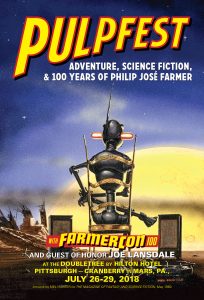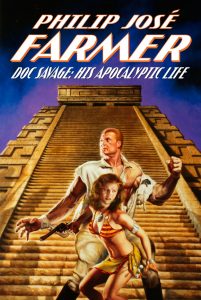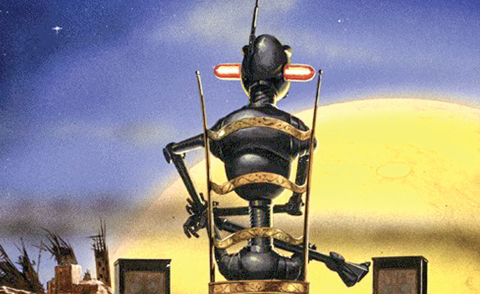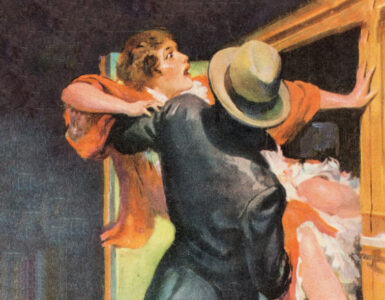 Over the last few months, we’ve been discussing that 2018 marks the centennial of the armistice that ended The First World War. However, our current year is also the hundredth anniversary of the birth of Grand Master of Science Fiction Philip José Farmer. Beginning on Thursday evening, July 26, and running through Sunday, July 29, PulpFest 2018 will honor both the 100th anniversary of the end of World War I AND the century mark of Philip José Farmer. We’ll be celebrating at the beautiful DoubleTree by Hilton Hotel Pittsburgh – Cranberry, just outside Pennsylvania’s Steel City.
Over the last few months, we’ve been discussing that 2018 marks the centennial of the armistice that ended The First World War. However, our current year is also the hundredth anniversary of the birth of Grand Master of Science Fiction Philip José Farmer. Beginning on Thursday evening, July 26, and running through Sunday, July 29, PulpFest 2018 will honor both the 100th anniversary of the end of World War I AND the century mark of Philip José Farmer. We’ll be celebrating at the beautiful DoubleTree by Hilton Hotel Pittsburgh – Cranberry, just outside Pennsylvania’s Steel City.
Few people think of Philip José Farmer as a pulp writer, but he was a child of the pulps and launched his career in the pulps. Born January 26, 1918 in North Terre Haute, Indiana, Farmer grew up in Peoria, Illinois. He spent much of his childhood reading everything he could find in the local library and drug store. From the classics by Baum, Carroll, Cervantes, Chesterton, Cooper, Defoe, Dickens, Dumas, Homer, London, Shaw, Stevenson, Swift, Thackeray, Twain, Verne, Wells, and others, to popular fiction by Burroughs, Doyle, Haggard, and on through the pulps: AIR WONDER STORIES, ARGOSY, BLUE BOOK, DOC SAVAGE, SCIENCE WONDER STORIES, THE SHADOW, WEIRD TALES . . . the list goes on and on. He also read the Bible and many books on mythology.
His wide reading prepared Farmer well for a career as a writer. Before trying his hand at science fiction, he wrote mainstream stories. He sold his first story, “O’Brien and Obrenov,” to ADVENTURE magazine. It was published in the March 1946 issue. His first science fiction story, “The Lovers” — published in the August 1952 STARTLING STORIES — is famous for breaking the taboo on sex in science fiction. It launched his science fiction career and won Farmer the 1952 Hugo Award as the “Most Promising New Talent.”
After selling several more stories to STARTLING STORIES, THRILLING WONDER STORIES, and SCIENCE FICTION PLUS, Farmer entered and won the Shasta Prize Novel Contest in 1953. The award included a grand prize of four thousand dollars (about $36,000 in today’s dollars). Though married with two children, Farmer now felt confident enough to quit his job and become a full-time writer. Unfortunately, his career immediately hit a stumbling block when Shasta didn’t pay him the prize money. Instead they strung him along asking for rewrites, while investing the money in the publication of another book. It bombed. Farmer was never paid and by the time the truth came out, he had lost his house and had to find full-time work.
After falling back on manual labor jobs for a few years, Farmer and his family left Peoria in 1956 and moved around the country. He worked as a technical writer for the space-defense industry, eventually ending up in Beverly Hills in 1965. All the while, he continued to write and sell science fiction short stories to such pulps and digests as AMAZING STORIES, ARGOSY, BEYOND FANTASY FICTION, FANTASTIC UNIVERSE, GALAXY, THE MAGAZINE OF FANTASY & SCIENCE FICTION, THE SAINT MYSTERY MAGAZINE, WORLDS OF IF, and WORLDS OF TOMORROW. He also wrote novels and published stories in anthologies. In 1967, he won a second Hugo Award for the story “Riders of the Purple Wage,” published in DANGEROUS VISIONS. Then — just before the moon landing in 1969 — he was laid off from his technical writing job. Once again, Farmer turned to full-time fiction writing.
In 1970, the Farmers moved back to Peoria and his writing career again began to take off. His World of Tiers series was very popular and he received his third Hugo Award for the first novel in the Riverworld series, TO YOUR SCATTERED BODIES GO. A reworking of the novel that had won the Shasta contest, Farmer’s novel won the 1972 Hugo. Soon thereafter, his career hit another obstacle: writer’s block.
Although fans and publishers alike were clamoring for the next World of Tiers or Riverworld title, Farmer seemed to be out of ideas. Unable to work in those worlds, he spent the next few years looking to his favorite literature and the pulps for inspiration: THE WIND WHALES OF ISHMAEL (a science fiction sequel to MOBY DICK); THE OTHER LOG OF PHILEAS FOGG (the true story behind Jules Verne’s AROUND THE WORLD IN EIGHTY DAYS); THE ADVENTURE OF THE PEERLESS PEER (a pastiche of Tarzan and Sherlock Holmes); HADON OF ANCIENT OPAR and FLIGHT TO OPAR (inspired by Edgar Rice Burroughs and H. Rider Haggard); and VENUS ON THE HALF-SHELL, written “by” Kilgore Trout (wherein Farmer pretended he was Kurt Vonnegut Jr.’s sad-sack science fiction author).
 Farmer also penned two biographies during this period — TARZAN ALIVE: A DEFINITIVE BIOGRAPHY OF LORD GREYSTOKE and DOC SAVAGE: HIS APOCALYPTIC LIFE — revealing to the world that the “characters” known as Tarzan and Doc Savage were, in fact, based on real, living people. These books also served to introduce the Wold Newton Family mythos, a concept that may be one of his most enduring creations.
Farmer also penned two biographies during this period — TARZAN ALIVE: A DEFINITIVE BIOGRAPHY OF LORD GREYSTOKE and DOC SAVAGE: HIS APOCALYPTIC LIFE — revealing to the world that the “characters” known as Tarzan and Doc Savage were, in fact, based on real, living people. These books also served to introduce the Wold Newton Family mythos, a concept that may be one of his most enduring creations.
With his writer’s block vanquished by the end of the 1970s, Farmer continued the Riverworld and World of Tiers series. The next two decades also saw the fulfillment of his life-long ambitions to write an Oz book and to author official Doc Savage and Tarzan novels: A BARNSTORMER IN OZ, ESCAPE FROM LOKI, and THE DARK HEART OF TIME.
Farmer enjoyed a long career and attended hundreds of conventions, many of them as a guest of honor (including PulpCon in 1989). Although he retired from writing in 1999, he worked with an ardent fan base over the next decade that continued to make his work available. Projects ranged from a mammoth collection of rarities (PEARLS FROM PEORIA, published in 2006) to unsold mainstream stories written at the start of his career and collected alongside an unpublished novel (UP FROM THE BOTTOMLESS PIT AND OTHER STORIES, published in 2007). Also published were new editions of novels, new collections, and unfinished works, completed in collaboration with others: “Getting Ready to Write” (with Paul Spiteri), THE CITY BEYOND PLAY and DAYWORLD: A HOLE IN WEDNESDAY (both with Danny Adams), THE EVIL IN PEMBERLEY HOUSE (with Win Scott Eckert), and THE SONG OF KWASIN (with Christopher Paul Carey).
Philip José Farmer passed away on February 25, 2009, shortly after his 91st birthday. His legacy endures and continues to entertain his many fans and readers. Perhaps the best testament to this is the annual FarmerCon gathering, held at PulpFest since 2011.
What better way to celebrate the 100th birthday of Philip José Farmer than by registering for Pulpfest 2018/FarmerCon 100? The Science Fiction Grand Master will be one of the main themes of the conventions, with plenty of programing about Farmer and his work. Also on hand will be the conventions’ Guest of Honor — Joe Lansdale — the author of over forty novels, numerous short stories, and the introduction to THE BEST OF PHILIP JOSÉ FARMER. You can join both conventions by clicking the Register for 2018 button on the PulpFest home page. And don’t forget to book a room at the DoubleTree while you’re visiting the PulpFest site. They’re going fast!
(While working in the aerospace and defense industry as a technical writer, Philip José Farmer continued to write and sell science fiction to the pulp and digest markets. THE MAGAZINE OF FANTASY AND SCIENCE FICTION — which published “Open to Me, My Sister” in its May 1960 issue, featuring front cover art by Mel Hunter — was one of many magazines to which he sold.
By the 1970s, Farmer was writing fiction full time, winning the Hugo Award for “Best Novel” in 1972. Additionally, he penned many works inspired by the classics of literature and the pulps of his youth. One of these was the fictional “biography,” DOC SAVAGE: HIS APOCALYPTIC LIFE. A revised edition of this work — with bonus material — was published in 2013 by Meteor House and Altus Press. It featured front cover art by Joe DeVito.
Mike Croteau is one of the founders of FarmerCon and Meteor House. He’s also the founder and one of the developers of Philip José Farmer’s Official Web Page.)







